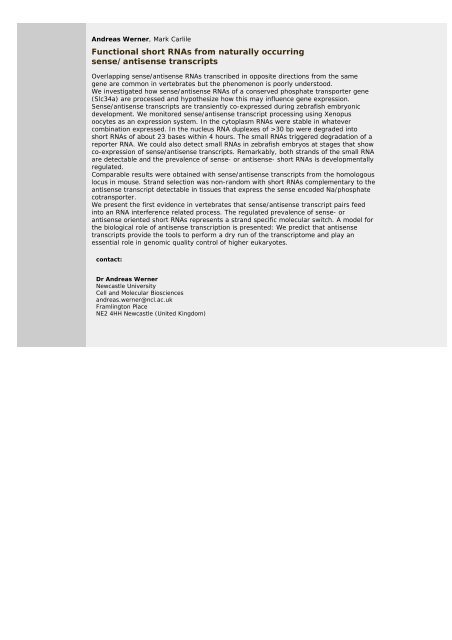Abstracts (poster) - Wissenschaft Online
Abstracts (poster) - Wissenschaft Online
Abstracts (poster) - Wissenschaft Online
You also want an ePaper? Increase the reach of your titles
YUMPU automatically turns print PDFs into web optimized ePapers that Google loves.
Andreas Werner, Mark Carlile<br />
Functional short RNAs from naturally occurring<br />
sense/antisense transcripts<br />
Overlapping sense/antisense RNAs transcribed in opposite directions from the same<br />
gene are common in vertebrates but the phenomenon is poorly understood.<br />
We investigated how sense/antisense RNAs of a conserved phosphate transporter gene<br />
(Slc34a) are processed and hypothesize how this may influence gene expression.<br />
Sense/antisense transcripts are transiently co-expressed during zebrafish embryonic<br />
development. We monitored sense/antisense transcript processing using Xenopus<br />
oocytes as an expression system. In the cytoplasm RNAs were stable in whatever<br />
combination expressed. In the nucleus RNA duplexes of >30 bp were degraded into<br />
short RNAs of about 23 bases within 4 hours. The small RNAs triggered degradation of a<br />
reporter RNA. We could also detect small RNAs in zebrafish embryos at stages that show<br />
co-expression of sense/antisense transcripts. Remarkably, both strands of the small RNA<br />
are detectable and the prevalence of sense- or antisense- short RNAs is developmentally<br />
regulated.<br />
Comparable results were obtained with sense/antisense transcripts from the homologous<br />
locus in mouse. Strand selection was non-random with short RNAs complementary to the<br />
antisense transcript detectable in tissues that express the sense encoded Na/phosphate<br />
cotransporter.<br />
We present the first evidence in vertebrates that sense/antisense transcript pairs feed<br />
into an RNA interference related process. The regulated prevalence of sense- or<br />
antisense oriented short RNAs represents a strand specific molecular switch. A model for<br />
the biological role of antisense transcription is presented: We predict that antisense<br />
transcripts provide the tools to perform a dry run of the transcriptome and play an<br />
essential role in genomic quality control of higher eukaryotes.<br />
contact:<br />
Dr Andreas Werner<br />
Newcastle University<br />
Cell and Molecular Biosciences<br />
andreas.werner@ncl.ac.uk<br />
Framlington Place<br />
NE2 4HH Newcastle (United Kingdom)

















